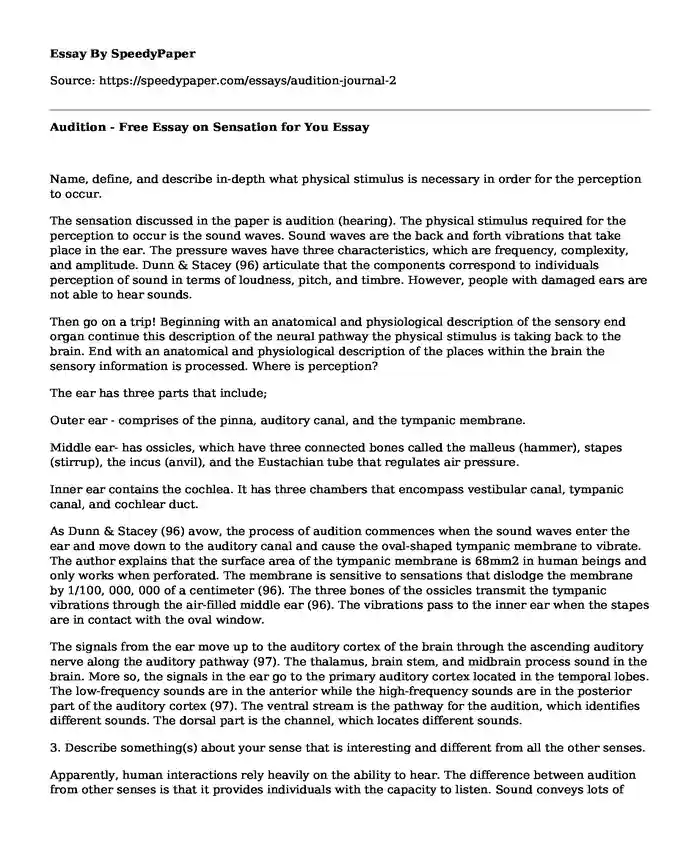Name, define, and describe in-depth what physical stimulus is necessary in order for the perception to occur.
The sensation discussed in the paper is audition (hearing). The physical stimulus required for the perception to occur is the sound waves. Sound waves are the back and forth vibrations that take place in the ear. The pressure waves have three characteristics, which are frequency, complexity, and amplitude. Dunn & Stacey (96) articulate that the components correspond to individuals perception of sound in terms of loudness, pitch, and timbre. However, people with damaged ears are not able to hear sounds.
Then go on a trip! Beginning with an anatomical and physiological description of the sensory end organ continue this description of the neural pathway the physical stimulus is taking back to the brain. End with an anatomical and physiological description of the places within the brain the sensory information is processed. Where is perception?
The ear has three parts that include;
Outer ear - comprises of the pinna, auditory canal, and the tympanic membrane.
Middle ear- has ossicles, which have three connected bones called the malleus (hammer), stapes (stirrup), the incus (anvil), and the Eustachian tube that regulates air pressure.
Inner ear contains the cochlea. It has three chambers that encompass vestibular canal, tympanic canal, and cochlear duct.
As Dunn & Stacey (96) avow, the process of audition commences when the sound waves enter the ear and move down to the auditory canal and cause the oval-shaped tympanic membrane to vibrate. The author explains that the surface area of the tympanic membrane is 68mm2 in human beings and only works when perforated. The membrane is sensitive to sensations that dislodge the membrane by 1/100, 000, 000 of a centimeter (96). The three bones of the ossicles transmit the tympanic vibrations through the air-filled middle ear (96). The vibrations pass to the inner ear when the stapes are in contact with the oval window.
The signals from the ear move up to the auditory cortex of the brain through the ascending auditory nerve along the auditory pathway (97). The thalamus, brain stem, and midbrain process sound in the brain. More so, the signals in the ear go to the primary auditory cortex located in the temporal lobes. The low-frequency sounds are in the anterior while the high-frequency sounds are in the posterior part of the auditory cortex (97). The ventral stream is the pathway for the audition, which identifies different sounds. The dorsal part is the channel, which locates different sounds.
3. Describe something(s) about your sense that is interesting and different from all the other senses.
Apparently, human interactions rely heavily on the ability to hear. The difference between audition from other senses is that it provides individuals with the capacity to listen. Sound conveys lots of information about the environment. Human beings, who are unable to see, detect taste, smell, or feelings can adapt to environmental sounds and hear peoples voices.
Work Cited
Stacey, Paula., & Dunn, Andrew. An Introduction to Sensation, Perception and Attention. Essential Psychology. 2014.
Web. November 16, 2016. Available at http://uk.sagepub.com/sites/default/files/upm-binaries/67102_Banyard_ch6_web.pdf
Cite this page
Audition - Free Essay on Sensation for You. (2019, Dec 09). Retrieved from https://speedypaper.com/essays/audition-journal-2
Request Removal
If you are the original author of this essay and no longer wish to have it published on the SpeedyPaper website, please click below to request its removal:
- Essay Example on the Impact of Climate Change on Business
- Free Essay on Transmission Lines, Electromagnetics
- Free Essay Sample on Adverse Drug Reactions
- Rural Life vs. Metropolitan Life, Essay Sample for Students
- Essay Example: Innovation of Handbags Overtime
- Essay Sample on Insight of Bullying
- Mathematics Class Discussion - Free Essay Example
Popular categories





